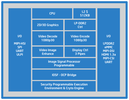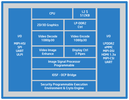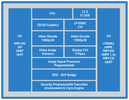Intel Atom Z2000 vs Intel Atom Z2460 vs Intel Atom Z2480
Intel Atom Z2000
► remove from comparison
The Intel Atom Z2000 is a SoC (System on a Chip) with the Codename Penwell and part of the Medfield platform. The Z2000 is a low end part and integrates a single core Atom processor (Saltwell) clocked at 1.0 GHz (no Hyper Threading, no turbo).
The Saltwell CPU core is still very similar to the first Intel Atom. Therefore, the performance per clock should be very similar (only very small enhancements). However, the CPU now features additional 256 KB low-power-cache (on a separate voltage plane) to allow the CPU and L2 cache to enter a lower power state. Furthermore, the CPU core can be downclocked to 100 MHz (in 100 MHz steps) to save power.
The processor performance should be on a level with a previous generation Atom processor clocked at 1.0 GHz (e.g., the Atom Z510 clocked at 1.1 GHz). Compared to other smartphone SoCs, the Z2000 is a low end solution.
The integrated graphics card is based on a PowerVR SGX 540 design and clocked at 320 MHz. The video decoder (MPEG4.2, H.264, VC1, WMV) and encoder (MPEG4.2, H.264) also stem from Imagination Technologies (VDX385 and VDE285) and should allow 1080p30 de- and encoding of videos.
Furthermore, a dual channel LPDDR2 memory controller (2x 32 Bit) for a maximum of 1GB RAM is integrated.
The whole SoC was optimized for power efficiency and low power consumption. It is produced with a 32nm LP (low power) process. At 100 MHz the SoC should consume about 50 mW and at 1.0 GHz about 300 - 400 mW. Therefore, the Z2000 is even suited for smartphones.
Sources: Anandtech
Intel Atom Z2460
► remove from comparison
The Intel Atom Z2460 is a SoC (System on a Chip) with the Codename Penwell and part of the Medfield platform. The Z2460 is a one chip SoC and integrates a single core Atom processor (Saltwell) clocked at 1.3 - 2.0 GHz. Due to Hyper-Threading two threads can be executed on the single core (for improved efficiency).
The Saltwell CPU core is still very similar to the first Intel Atom. Therefore, the performance per clock should be very similar (only very small enhancements). However, the CPU now features additional 256 KB low-power-cache (on a separate voltage plane) to allow the CPU and L2 cache to enter a lower power state. Furthermore, the Atom now supports some sort of Turbo Boost and can reach up to 2.0 GHz shortly (1.3 GHz base frequency). Furthermore, the CPU core can be downclocked to 100 MHz (in 100 MHz steps) to save power.
The processor performance should be on a level with a previous generation Atom processor clocked at 1.3 - 2.0 GHz (e.g., the Atom Z670 clocked at 1.5 GHz). Other smartphone SoCs based on ARM cores should be slower according to Intel. The SunSpider Javascript Benchmark and the BrowserMark scores for example should be higher than using a TI OMAP 4460 (Galaxy Nexus) or Apple A5 (iPhone 4S).
The integrated graphics card is based on a PowerVR SGX 540 design and clocked at 400 MHz. The video decoder (MPEG4.2, H.264, VC1, WMV) and encoder (MPEG4.2, H.264) also stem from Imagination Technologies (VDX385 and VDE285) and should allow 1080p30 de- and encoding of videos.
Furthermore, a dual channel LPDDR2 memory controller (2x 32 Bit) for a maximum of 1GB RAM is integrated.
The whole SoC was optimized for power efficiency and low power consumption. It is produced with a 32nm LP (low power) process. At 100 MHz the SoC should consume about 50 mW and at 1.6 GHz about 750 mW. Therefore, the Z2460 is even suited for smartphones and Intel is keen to point out the the average power consumption is very good compared to competitors like the iPhone 4S.
Sources: Anandtech
Intel Atom Z2480
► remove from comparison
The Intel Atom Z2480 is a SoC (System on a Chip) with the Codename Penwell and part of the Medfield platform. The Z2480 is a one chip SoC and integrates a single core Atom processor (Saltwell) clocked at up to 2.0 GHz. Due to Hyper-Threading two threads can be executed on the single core (for improved efficiency).
The Saltwell CPU core is still very similar to the first Intel Atom. Therefore, the performance per clock should be very similar (only very small enhancements). However, the CPU now features additional 256 KB low-power-cache (on a separate voltage plane) to allow the CPU and L2 cache to enter a lower power state. Furthermore, the Atom now supports some sort of Turbo Boost and can reach up to 2.0 GHz shortly (1.3 GHz base frequency). Furthermore, the CPU core can be downclocked to 100 MHz (in 100 MHz steps) to save power.
The processor performance should be on a level with a previous generation Atom processor clocked at 2.0 GHz (e.g., the Z550). Due to the X86 architecture, native ARM code on Android has to be translated on the fly and therefore the performance may degrade on certain applications.
The integrated graphics card is based on a PowerVR SGX 540 design and clocked at 400 MHz. The video decoder (MPEG4.2, H.264, VC1, WMV) and encoder (MPEG4.2, H.264) also stem from Imagination Technologies (VDX385 and VDE285) and should allow 1080p30 de- and encoding of videos.
Furthermore, a dual channel LPDDR2 memory controller (2x 32 Bit) for a maximum of 1GB RAM is integrated.
The whole SoC was optimized for power efficiency and low power consumption. It is produced with a 32nm LP (low power) process.
| Model | Intel Atom Z2000 | Intel Atom Z2460 | Intel Atom Z2480 | ||||||||||||||||||||||||||||||||||||
| Codename | Penwell | Penwell | Penwell | ||||||||||||||||||||||||||||||||||||
| Series | Intel Atom | Intel Atom | Intel Atom | ||||||||||||||||||||||||||||||||||||
| Series: Atom Penwell |
|
|
| ||||||||||||||||||||||||||||||||||||
| Clock | 1000 MHz | 1300 - 1600 MHz | 2000 MHz | ||||||||||||||||||||||||||||||||||||
| L1 Cache | 56 KB | 56 KB | 56 KB | ||||||||||||||||||||||||||||||||||||
| L2 Cache | 512 KB | 512 KB | 512 KB | ||||||||||||||||||||||||||||||||||||
| Cores / Threads | 1 / 1 | 1 / 2 | 1 / 2 | ||||||||||||||||||||||||||||||||||||
| Technology | 32 nm | 32 nm | 32 nm | ||||||||||||||||||||||||||||||||||||
| Architecture | x86 | x86 | x86 | ||||||||||||||||||||||||||||||||||||
| Announced | |||||||||||||||||||||||||||||||||||||||
| TDP | 4? Watt | ||||||||||||||||||||||||||||||||||||||
| iGPU | PowerVR SGX540 (400 MHz) | PowerVR SGX540 (400 MHz) | |||||||||||||||||||||||||||||||||||||
| Features | SSE3, Execute Disable Bit, PowerVR SGX 540, 2x 32 Bit LPDDR2-800 | ||||||||||||||||||||||||||||||||||||||
| Manufacturer | www.intel.com |
Benchmarks
Average Benchmarks Intel Atom Z2460 → 0% n=0
Average Benchmarks Intel Atom Z2480 → 0% n=0
* Smaller numbers mean a higher performance
1 This benchmark is not used for the average calculation













